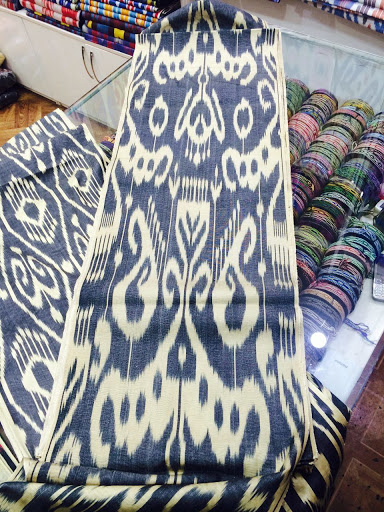Tavsif
Tanda ipi tabiiy ipakdan, arqog‘i qalin ipdan to‘qilgan gazlama. Guli ikki tomonlama bo‘lganligi uchun ayrim joylarda duro‘ya deb ataladi. Arqoq ipi yo‘g‘onroq bo‘lganligi uchun gazlama yuzasida ko‘ndalang chiviqlar hosil bo‘ladi. Kudunglanish natijasida yuqori navli Adrasning bir tomoni at-lasday silliq bo‘lib, ikkinchi tomoni tovlanib turadi. Gullari abr usulida bo‘lib sariq, ko‘k, pushti, qizil ranglar qo‘llanilgan. 1920-yillargacha Marg‘ilon, Xo‘jand, Buxoro, Samarqand va boshqa joylarda to‘qilib, O‘rta Osiyo bozorlaridan tashqari Afg‘oniston, Xitoy kabi qo‘shni mamlakatlarda ham sotilgan. Adras o‘zbek xalqi hayotida keng tarqalgan bo‘lib, ayollarning kiyim-kechaklari, shuningdek chopon, ko‘rpa va ko‘rpachalar uchun ishla-tilgan. Adras tun – avrasi Adras dan tiqilgan to‘n.
Description
It is a fabric made of natural silk with a thick thread on the back. Because the back strap is thicker, transverse stitches are formed on the surface of the fabric. As a result, one side of the high-grade Adras is as smooth as a horse and the other side is shiny. The flowers are yellow, blue, pink and red. Until the 1920s, it was woven in Margilan, Khojand, Bukhara, Samarkand and other places, and sold not only in Central Asian markets, but also in neighboring countries such as Afghanistan and China. Adras is common in Uzbek life and is used for women's clothing, as well as coats, blankets and heavy quilted mattresses and the bride's dowry gifted by the groom.
Misol(lar)
|
Saroyning to‘rida boshqalarg‘a qarag‘anda ko‘rkamrak bir hujra, anovi hujralarga kiygiz to‘shalgani holda bu hujrada qip-qizil gilam, uttalarda bo‘z ko‘rpalar ko‘rilgan bo‘lsa, munda ipak va adras ko‘rpalar, narigilarda qora charog‘ sasig‘anda, bu hujrada sham’ yonadir, o‘zga hujralarda yengil tabi’atlik, serchaqchaq kishilar bo‘lg‘anida bu hujraning egasi boshqacha yaratilishda. Manba: Abdulla Qodiriy, O`tkan kunlar |
|
Ul o‘z uyida o‘lturg‘anida ham ustidagi atlas ko‘ynak bilan adras mursakni, oq shohi dakana bilan kahrabo tasbihni qo‘ymay, qish kunlari tanchadan par yostiqqa suyalib, yoz kunlari ayvonning to‘riga yoslanib Hasanalining xotini bo‘lg‘an Oybodoqqa, cho‘ri qiz Hanifaga xamirni achitmaslikni, palovni qirmoch oldirmasliqni tanbihlabkina o‘lturar edi. Manba: Abdulla Qodiriy, O'tkan kunlar |
Example(s)
|
At the far end of the main yard, a room stood apart from the others through its singular beauty: while the other rooms bore only felt rugs, this room displayed deep-red carpets; while others laid their heads on cotton quilts, here the owner slept among silk and adras bedding; while the other living quarters reeked of the soot of blackened lamps, this small room was lit with a single brilliant candle; and while the other tenants displayed a carefree and facetious nature, the occupant of this room appeared to be cast from another material altogether Manba: Abdulla Qadiriy, Bygone Days |
|
When at home, she usually wore a silk atlas shirt under an adras overcoat, accompanied by a white silk turban as worn by ladies, with amber prayer beads in her hands. Uzbek Oyim reclined on a fur pillow near a sandal during the winter months. The summer months were spent under the shade of the veranda, from where she gave directions to Oibadak, wife of Hasan Ali, and the slave girl Hanifa. Uzbek Oyim was preoccupied with teaching Hanifa her household duties—such as how not to spoil the dough or burn the bottom of the Plov. Manba: Abdulla Qadiriy, Bygone days |
